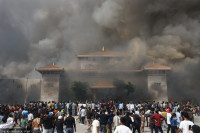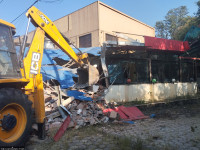Kathmandu
As monsoon kicks off, KMC races to fix roads to landfill site
The city office has also started dredging Valley’s rivers to prevent inundation problems.
Post Report
In a bid to prevent obstruction of waste disposal during the monsoon season, the Kathmandu Metropolitan City has expedited maintenance of the road to the Bancharedanda landfill in Nuwakot.
Officials say road maintenance works are in full swing in various places along the Tinpiple-Bancharedanda road section, and contractors have been asked to complete the tasks at the earliest.
“Most of the construction works—concretisation, blacktopping, pothole filling, drainage cleaning, landslide debris removal will be completed within weeks,” said Uddhab Nepal, site in-charge of the metropolis. “Construction of a retaining wall in Sisdole may take longer time to complete, but the contractors are working there too.”
Every year, during monsoon season, the road to landfill sites gets obstructed in multiple places, obstructing the transfer of household waste collected in the three districts of the Kathmandu Valley—Kathmandu, Lalitpur, and Bhaktapur. Apart from these, some local units of Kavrepalanchok and Nuwakot also dispose of garbage at the landfill site at Bancharedanda.
Obstacles on the road to a landfill site will halt door-to-door garbage collection in the Kathmandu Valley, resulting in garbage piled up in streets, which not only makes life difficult but also poses a risk of the spread of diseases. Last year, the metropolis had deployed heavy equipment including bulldozers, excavators, and loaders, to clear the road to the landfill site.
“We have instructed contractors to complete the construction work as soon as possible,” said Sarita Rai, chief of the Environment Department under the city office. “We have also asked the private companies involved in garbage collection from households to take the waste to the landfill site every day.”
The city office has allocated Rs80 million to maintain the road to the landfill site. The office said that it has also kept some heavy equipment on standby for immediate deployment if needed.
The Kathmandu Valley generates over 1,200 tonnes of solid waste every day, nearly 60 percent of which comes from the KMC alone. Over 200 trucks take the waste collected from 23 local units of the Valley and adjoining districts—Kavrepalanchowk, Nuwakot and Dhading—to the landfill.
KMC officials said that apart from the expedition of road repair and maintenance work, they have also started dredging the Valley’s rivers to prevent the repetition of last year’s inundation problems.
“We have used several excavators and tipper trucks—both our [KMC’s] own and private companies to clear sediments and debris from rivers,” said Rai. “Work is ongoing simultaneously in Bagmati and Bishnumati rivers.”
Several settlements and roads in the river corridors were inundated due to a flood triggered by heavy rain last year. The KMC has also purchased 10 high-pressure pumps to pump water from inundated settlements.
This year, the monsoon entered the country 15 days before the usual onset date of June 13. The Department of Hydrology and Meteorology has predicted that Nepal is likely to witness above-normal monsoon rainfall this year.
Above-normal rains could spell more disasters, including flash floods, landslides and inundation.




 16.12°C Kathmandu
16.12°C Kathmandu











